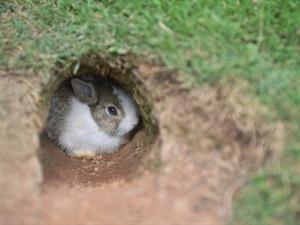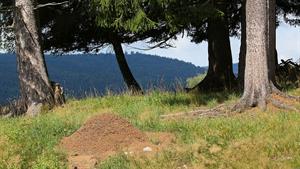PDF chapter test TRY NOW
Explore the meadow houses,
The burrows in the ground,
A nest beneath tall grasses,
The ant’s amazing mound.
The burrows in the ground,
A nest beneath tall grasses,
The ant’s amazing mound.
Explanation:
Later, the poet speaks about the meadow houses such as burrows, nests, and anthills. The meadow becomes a town by itself with all the various types of houses in it. The poet asks us to explore these houses while we are at the meadow.
The burrows are holes or tunnels found in the grounds.
The burrows are holes or tunnels found in the grounds.

A rabbit in its burrow
Animals dig them to create a space suitable for living. Burrows become homes to animals such as rabbits, moles, chipmunks, weasels, and several types of rodents.
Nests are built by birds. They are made on trees so that the birds could lay or leave their eggs in to develop. Sometimes nests are also found among tall grasses. Nests are considered as homes to several birds.
Nests are built by birds. They are made on trees so that the birds could lay or leave their eggs in to develop. Sometimes nests are also found among tall grasses. Nests are considered as homes to several birds.

A bird's nest
Besides the burrows and nests, one could also find the homes of ants in the meadows. They are called anthills or ant colony. Have you seen an ant colony? If not, have you seen the animated movie "A Bug's Life" (1998)? The film shows us what an ant colony looks like.
Back to the "Meadow Surprises", the poet describes ants’ home as an "amazing mound". The poet calls it a mound because the ant's house is in a shape of a pile. It is amazing because it is a wonder how a creature so tiny can create such an impressive structure.

Anthills
Meanings of difficult words from the stanza:
Sl. No. | Words | Meanings |
1 | Explore | Travel through an unfamiliar place in order to learn about it |
2 | Burrows | A hole or tunnel dug by a small animal, especially a rabbit, as a dwelling |
3 | Mound | A large pile of sand, stones, etc. like a small hill |
4 | Beneath | To be in a lower position than someone or something, or under someone or something |
Reference:
National Council of Educational Research and Training (2007). Honeycomb. Meadow Surprises: Lois Brandt Phillips (pp. 123-124). Published at the Publication Division by the Secretary, National Council of Educational Research and Training, Sri Aurobindo Marg, New Delhi.
